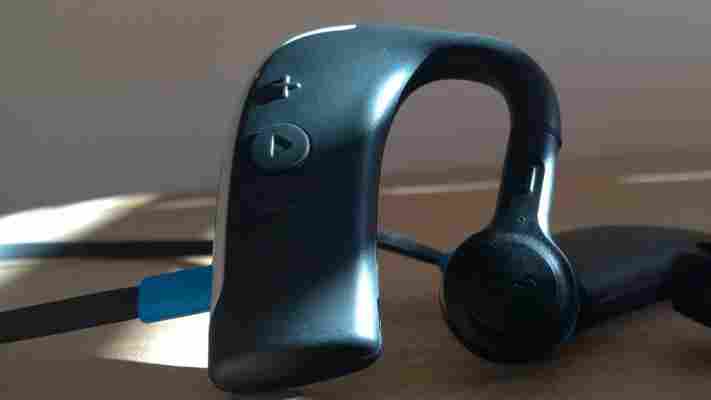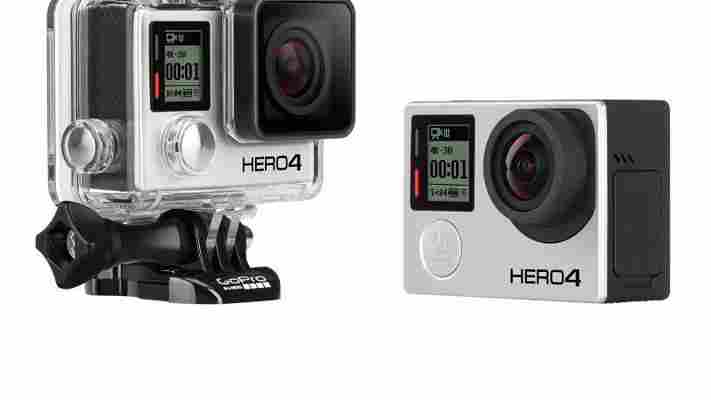Blue Ant has today announced that its HD Sportsbuds headphones are available in the UK, having first gone on sale in the US earlier in the year. With the promise of ‘wireless’ in-ear buds we wouldn’t have to take out from the start of a training session until stepping out of the shower, we decided a quick review was in order.

Blue Ant may not be as much of a household name as brands like Beats or Sol Republic , but we’re no stranger to the name, both for headphones and headsets. And with the PUMP HD now being offered for sale directly from Apple in the UK for £109 ($129 in the US), the brand’s exposure looks set to increase.
A spokesperson for the company told me that the UK is a stepping stone to Europe for the Sportsbuds, although exact availability in other regions wasn’t confirmed.
Unlike most in-ear headphones, the PUMP Sportsbuds have been designed with physical activity in mind and boast water, dust and sweat-resistance.
Officially, they’re IP67 rated for dust and water – meaning they’re totally protected against dust and can handle immersion in water at depths of between 1cm and 1 metre. So, the Sportsbuds aren’t really made for taking a dip in your local pool (unless you plan on keeping your head dry), but feel free to wash them clean after a workout or wear them in the shower.
As well as all sorts of ingress protections, the Sportsbuds have been designed to hold firm during physical activity and arrive with a number of differently sized earbuds. There’s also some ‘awareness’ tips that let in more background noise for greater awareness around you; these come in just one size.
While they’re referred to as ‘wireless’, there’s a flat rubber cord connecting the two earpieces, which really was the only reason that the earpieces did ever move during exercise – it almost felt a little heavy, but there’s a cord tightener which helps with this. There are also optional stabilizers for additional help with keeping them firmly in place.
The downside to the ruggedness and staying power is that the Blue Ant PUMP Sportsbuds aren’t the sleekest looking thing you’ll ever see, but if you can handle the slightly more ‘chunky’ design then the staying power in your ears is worth the sacrifice. No one looks good mid-workout anyway.
As well as functioning as headphones, they can also be used for taking calls and have volume and call control buttons on the side of the right earpiece.
It’s worth spending a bit of time trying the different size earpieces if you’re in doubt as to the best for you; a good fit makes a big difference to the overall comfort here and helps them to stay in place more firmly.
On that front the PUMPs do well and they certainly stayed in place better than a regular pair of headphones during a run. I’d definitely recommend using the stabilizers too, the way they sit against your ear really helps to keep both earpieces rooted firm.
Comfort-wise, I found that after a couple of hours I was ready to give my ears a break but noticed the headphones more when just wearing them around the house rather than working out. Shooting pain in other parts of your body tends to distract from minor discomfort of the ear, it seems.
Pleasantly, the actual sound quality from the PUMP HD Sportsbuds was punchy and bassy, which is to my personal taste and useful if you’re out and about in noisy environments, but it won’t suit everyone’s ears.
That volume and bass come at the cost of clarity, which could frustrate musical purists. For me, it was just fine and I’d value the PUMP HD’s other strong points against audio fidelity while working out.
The set-up worked well for calls too, although I didn’t find the controls particularly convenient to operate when accepting or ending one. I never quite seemed to be pressing the button on the first attempt. Quality-wise, I could always hear the other person well, but I sometimes got reports of excessive background noise, so it really depends on your surroundings.
The PUMP HD promises an eight hour battery life, and pretty much delivers, varying slightly depending on what volume level you’re listening at. Charging is simple enough using a microUSB, but remember to fully close the flap that covers the port on the buds as they’re not waterproof while it’s open.
Blue Ant’s PUMP HD Sportsbuds do a great job of staying firm if you take the time to get them as snugly-fitted as possible and deliver a hefty kick of bass to power you along when your energy is lacking. Plus, they’re simple to clean if you get them all sweaty.
Nonetheless, they aren’t going to be for everyone due to the slightly chunky design and £109/$129 asking price. That’s not particularly expensive for a primary set of headphones, but it’s perhaps more expensive than you’d like for a pair that you could only end up wearing at the gym. Still, if your daily workout is a big part of your life, £109 might not seem too excessive at all.
➤ Blue Ant PUMP HD Sportsbuds
How fitness apps and wearables can impact your performance at work
Brian Honigman is a marketing consultant, speaker and freelance writer. This post originally appeared on the SumAll blog .

In a pair of recent studies, the CDC called attention to two alarming trends. Americans are not getting nearly enough exercise and a majority fall many hours short of the recommended amount of sleep . Not only is this bad for our health, it harms our productivity as well.
Americans work more hours than workers in nearly any other country but it seems as if we are doing so by sacrificing our time for exercise and sleep. Unsurprisingly, the work we do while tired and unhealthy is not very productive.
An hour spent working instead of sleeping or exercising is not an even trade off. The secret to being as productive as possible is striking the right balance between taking care of ourselves while maximizing the time we spend working at peak productivity.
However, this is easier said than done. With such hectic schedules and many distractions it can simply be too hard to keep track of how much sleep and exercise we get and how much we need. Luckily, there are a host of tools that do this incredibly well.
Below are four examples of tangible gains in productivity that fitness apps like Fitbit can help you achieve.
Studies show that infrequent to no exercise correlates to a 50 percent increased risk of low productivity . The lesson here is that simply beginning even the lightest regiment of exercise can immediately lead to increased productivity.
Unfortunately many people do not have proper fitness habits in place, and these habits can prove tough to start. Fitness apps such as Fitbit excel at gently nudging users into healthy routines. For many who have not exercised in a very long time, regular reminders and instant feedback on small improvements can do wonders to drum up motivation.
When first beginning on the path to fitness it can be very easy to get discouraged. Making gains apparent in real time can help keep up a baseline level of exercise and help keep you motivated in the process. After committing to an exercise regimen with the help of Fitbit, it can quickly begin to increase your productivity and that in itself will provide additional motivation.
In a fascinating paper from Georgetown University, the authors discuss the many ways that leading an active lifestyle can benefit productivity. One surprising thing the paper noted was that seeing all of these benefits required only two hours and 30 minutes of exercise a week (a little more than 20 minutes a day).
This may not seem like a lot, but one of the core difficulties of achieving these productivity benefits is sticking to this regimen. In order to see the boost in productivity discussed, consistency is key.
For many, it might not be hard to get up and do exercise, but it may be very difficult to find the time to do so every single day.
One of the great benefits of fitness trackers like Fitbit is that they never forget or lose track of time. If you program your Fitbit to remind you of your commitment to 20 minutes of activity every single day, it will be much harder for you to forget. In addition, certain apps might even make you feel slightly guilty about “just skipping a day.”
Seeing that blank space on your fitness app’s progress chart or the blinking light on your Fitbit can serve as subtle yet powerful motivator. Not only will reminders like this help you keep consistent with your active lifestyle, they will also help cement the corresponding gains in your overall productivity.
As important as regular exercise is for boosting productivity, all of your gains can be offset if you are not paying equal attention to getting enough sleep. A study conducted by Boston’s Brigham and Women’s Hospital showed that sleep deprivation significantly hampers productivity and only worsens as time goes on.
These findings don’t seem shocking until you realize that the definition of “sleep deprivation” the researchers used was only getting six hours a night. That means roughly 40 percent of Americans are chronically sleep deprived. One thing these studies seem to reveal is that we severely underestimate the amount of sleep that we need to perform at our optimal level.
One benefit of fitness apps and trackers is that many also double as sleep trackers. Armed with a Fitbit and the knowledge that the recommended amount of sleep is eight hours a night, you can program this requirement much like you would program an exercise regiment. Access to this personal data will help give you a clear picture of your current sleep patterns and how far they are from the ideal.
This is particularly useful, because developing proper sleeping habits takes time and is highly dependent on repetition. Nearly all of us know to what extent even one night of deviation from our regular sleep schedule can throw off our entire cycle.
As was already discussed, the subtle reminders and motivation Fitbit and other fitness trackers provide can prove invaluable when it comes to sticking to predetermined goals that require consistency.
In addition, these two separate habits can complement each other. A commonly recommended remedy for poor sleeping habits or difficulty sleeping is regular daily exercise. In this case, fitness trackers can help facilitate a positive feedback cycle that will allow these good habits to become ingrained and further increase productivity.
While regular sleep and exercise can lead to improvements in many quantifiable ways, the sum total of all of these habits can lead to many intangible yet highly important benefits.
The majority of studies that measure the productivity effects of sleep and exercise typically judge based on individualized tasks such as pattern recognition and recall, but the modern workplace tends to demand more of workers than simple individual tasks. Perhaps the most crucial indicator of workplace success is the degree of cooperation between employees .
It turns out that well-exercised employees are more likely to work as team players and less likely to lose their temper with each other .
Conversely, a study that asked college students to perform a team-oriented task while deprived of sleep found that they were much more likely to report being frustrated with one another than the control group.
While fitness trackers like Fitbit can never directly cause someone to embrace a healthier approach to sleep and exercise, they can make doing so significantly easier for those who decide they want to.
Given how dramatic of an effect proper sleep and exercise can have on workplace productivity on both the individual and team level, encouraging such healthy behaviors should be much more prioritized than they currently are.
Instead of demanding later nights, and attempting to boost morale and cooperation with fancy workshops and retreats, maybe managers should just give the team the week off and buy them Fitbits instead.
How does your business encourage your employees to stay productive throughout the work day? Do you think devices like the FitBit can help impact your team’s well-being? Share your experiences below.
Read next: The best sleeping habits to enhance your productivity
Meet GoPro’s new cameras: HERO4 Black, HERO4 Silver and the $129 entry-level HERO
GoPro has a new range of portable action sports cameras that you can attach to your helmet, surfboard, bicycle or four-legged companion .

The company has three new cameras: The HERO4, separated into two tiers called Black and Silver, and a new entry-level option simply called the HERO.
The HERO4 Black is the most drool-worthy option, boasting 4K video recording at 30 frames per second or 2.7K footage at 50 frames per second. Full HD (1080p) has been bumped up to an eye-watering 120 frames per second and you can grab 8.3-megapixel photos from all of your recordings. If you’re not shooting video, the Black edition can take 12-megapixel images with a burst mode of 30 images per second. All of this will set you back $499.
A slightly less expensive option is the HERO 4 Silver. The same 12-megapixel stills are on offer, but video recording is limited to a slightly less spectacular 2.7K at 30 frames per second, full HD (1080p) at 60 frames per second and 720p at up to 120 frames per second. It’ll be available on store shelves for $399.
If 400 smackeroonies is still well beyond your price range, GoPro is teasing newcomers with a new beginner-friendly HERO model. It costs a more palatable $129 and offers full HD (1080p) footage at 30 frames per second, or 720p at 60 frames per second. More than enough for the casual user, I imagine.
➤ GoPro (via Press Release )
